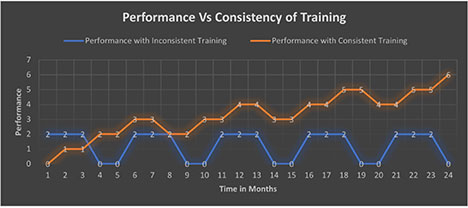Five tips for injury prevention
As fall sports pick back up, there is often an uptick in injuries associated with the increase in training load after a slower summer. Here are some helpful tips to help make the increased load feel more workable and prevent injuries from destabilizing your season.
Aug 16, 2022 | Brendan Copley, CSCS, ATC

As fall sports pick back up, there is often an uptick in injuries associated with the increase in training load after a slower summer. Here are some helpful tips to help make the increased load feel more workable and prevent injuries from destabilizing your season.
1. Listen to your body
While this is one of the most common recommendations you will hear — especially in the endurance sports realm — it is also one of the most commonly ignored. In the initial stages of getting back into your sport, it can be challenging to understand the difference between the normal discomfort of muscle soreness and injury-related pain.
On one hand, if you pay attention to every little ache and pain, you may not be able to reach the performance goals you desire. On the other hand, if you ignore your discomfort, you could be setting yourself up for injury and time away from your sport. This is where it can be helpful to work with an athletic trainer or physical therapist. As experts in the field, they will help you sort through the signals your body is telling you and brainstorm a plan of action.
2. Monitoring training load
Another place people can get stuck is the idea that because they have taken some time away from their sport, they need to work overtime to get themselves back into shape. So, they perform the most intense workout they could possibly fathom and are so sore that they are unable to walk for the next three days. Instead of pushing yourself, the more helpful (albeit more challenging approach) is to prioritize consistency over a long period of time
Consistency helps make your sport more of a habit; the more it is a habit, the less motivation is needed to perform the activity. The initial stages of training are all about building a base, and the more consistently you can get out there and recover appropriately, the bigger that base will be. One analogy is thinking of training as compound interest: if you can invest little amounts over a long period of time, eventually that interest will compound. On the flip side, if you must keep removing money from the bank, the interest will never add up.

3. Proper warm up and cool down
Performing an appropriate warm-up can also play a role in warding off soft tissue injury. Warm-ups increase the heart rate, increase blood flow to tight muscles, improve tissue elasticity, and prime the body for activity. The warm-up should consist of:
- Five minutes of an activity that increases your heart rate. This may consist of using a stationary bike, elliptical, running, jumping jacks, etc.
- Dynamic warm up which entails stretching targeted muscles through movement, while progressively promoting strength in functional movement patterns
- Pre-activation: this is a method of activating the hips, core, rotator cuff, and scapular stabilizing muscles depending on the sport and injury history. Pre-activation involves only one or two sets of movement with light to moderate resistance to prime muscles that help prevent the typical compensation patterns.
Performing an appropriate cool down usually includes performing some variation of very low intensity cardio for 5–10 minutes and some light static stretching.
4. Rest and recovery
Having the appropriate amount of sleep and time off are good methods to help make sure that your muscles have had time to restore the amount of energy needed before returning to training. The recommended amount of sleep for athletes is between seven and nine hours. As part of the recovery, it can also be beneficial to incorporate methods that either promote tissue elasticity or venous return. Some examples of these recovery methods are:
- Normatec
- Cryotherapy
- Foam rolling
- Massage therapy
- Trigger point release therapy
Nutrition and hydration also play an integral role in injury prevention. Nutrition can affect the recovery of the muscles, as well as the availability of energy while performing an activity. Here are some common nutrition-related concepts to keep in mind for fueling your body for optimal performance and injury prevention:
- Eat foods that are nutrient dense and have a variety of vitamins, minerals, and antioxidants
- To decrease inflammation, eat foods that are high in omega-3 fatty acids such as fish, ginger, turmeric, and nuts/seeds
- Eat foods that are high in protein approximately 30 minutes to an hour after the activity, but don’t disregard carbohydrates! Protein works best when it is eaten in 3:1 carb to protein ratio.
- Eat the appropriate ratio of fats, carbs, and protein for the type of sport being performed.
- The USDA recommends for the general public a macronutrient ratio of 45-65% carbs, 20-25% fats, and 10-35%
- Refer to a sports dietician who can perform a comprehensive evaluation to help determine your specific macronutrient needs
- In general endurance athletes tend to need a slightly higher percentage (60-65%) of their calories from carbohydrates.
- To avoid over or under fueling, have the appropriate caloric intake based off your Basal Metabolic Rate (BMR) and intensity of the exercise.
Regarding hydration, even mild dehydration can increase the likelihood of injury while also decreasing your body’s speed, strength, and cognitive function. Here are a few hydration facts to drink up to help feel your best and decrease injuries.
- It is important to hydrate throughout the day, not just right before activity. Dehydration is cumulative and the hydration status the day before affects the hydration of the day of.
- Aim to have 8–16 oz of water the hour before exercise, 4 oz per 15 mins of activity during activity, and 16-20 oz for every pound lost during exercise.
- For particularly hot time periods with intense training, it can be helpful to consistently weigh yourself both before and after the activity to make sure you are making up the fluid weight lost before starting up the next activity.
- In the heat it is also important to combine water intake with electrolytes drinks that have plenty of (sodium, potassium, magnesium and calcium.)
Unfortunately, both hydration and nutrition recommendations vary depending on the individual’s needs. Therefore, working with a nutritionist or dietician can be invaluable in curtailing recommendations specific to your situation.
The best type of treatment for injuries is a preventative plan. Building healthy habits around activity load, rest/recovery, listening to your body, warm-ups/cool downs, and nutrition/hydration can make a significant difference in your long-term health and well-being. You don’t have to take steps towards change alone. A good healthcare team should be able to work with their patient proactively to help determine a plan, before the injury even happens.

Brendan Copley
Brendan Copley, CSCS, ATC, is a personal trainer who specializes in working with endurance athletes and post-rehab clients.
